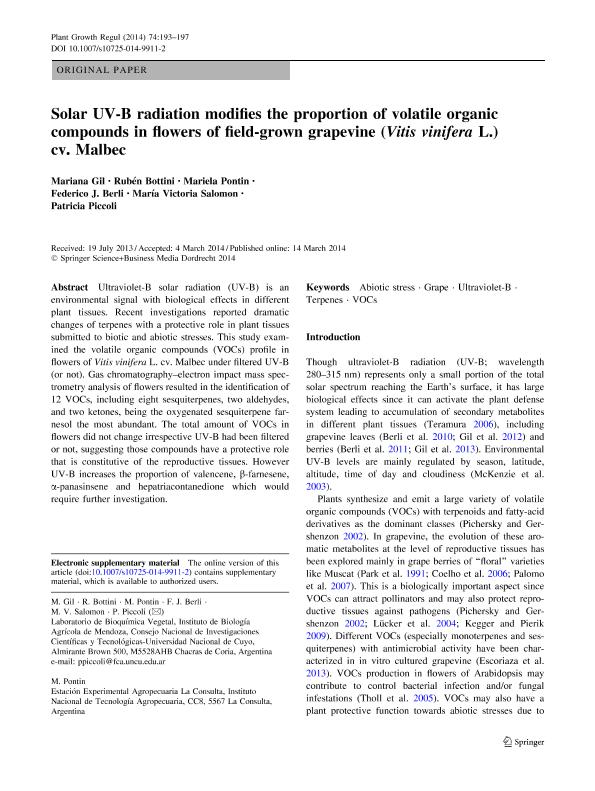Artículo
Solar UV-B radiation modifies the proportion of Volatile Organic Compounds in flowers of field-grown grapevine (Vitis vinifera L.) cv. Malbec
Gil, Mariana; Bottini, Rubén; Pontin, Mariela Ana ; Berli, Federico Javier
; Berli, Federico Javier ; Salomon, María Victoria
; Salomon, María Victoria ; Piccoli, Patricia Noemí
; Piccoli, Patricia Noemí
 ; Berli, Federico Javier
; Berli, Federico Javier ; Salomon, María Victoria
; Salomon, María Victoria ; Piccoli, Patricia Noemí
; Piccoli, Patricia Noemí
Fecha de publicación:
03/2014
Editorial:
Springer
Revista:
Plant Growth Regulation
ISSN:
0167-6903
Idioma:
Inglés
Tipo de recurso:
Artículo publicado
Clasificación temática:
Resumen
Ultraviolet-B solar radiation (UV-B) is an environmental signal with biological effects in different plant tissues. Recent investigations reported dramatic changes of terpenes with a protective role in plant tissues submitted to biotic and abiotic stresses. This study examined the volatile organic compounds (VOCs) profile in flowers of Vitis vinifera L. cv. Malbec under filtered UV-B (or not). Gas chromatography-electron impact mass spectrometry analysis of flowers resulted in the identification of 12 VOCs, including eight sesquiterpenes, two aldehydes, and two ketones, being the oxygenated sesquiterpene farnesol the most abundant. The total amount of VOCs in flowers did not change irrespective UV-B had been filtered or not, suggesting those compounds have a protective role that is constitutive of the reproductive tissues. However UV-B increases the proportion of valencene, b-farnesene, a-panasinsene and hepatriacontanedione which would require further investigation.
Palabras clave:
Abiotic Stress
,
Grape
,
Ultraviolet-B
,
Terpenes
,
Vocs
Archivos asociados
Licencia
Identificadores
Colecciones
Articulos(IBAM)
Articulos de INST.DE BIOLOGIA AGRICOLA DE MENDOZA
Articulos de INST.DE BIOLOGIA AGRICOLA DE MENDOZA
Citación
Bottini, Rubén; Pontin, Mariela Ana; Piccoli, Patricia Noemí; Berli, Federico Javier; Gil, Mariana; Salomon, María Victoria; et al.; Solar UV-B radiation modifies the proportion of Volatile Organic Compounds in flowers of field-grown grapevine (Vitis vinifera L.) cv. Malbec; Springer; Plant Growth Regulation; 74; 2; 3-2014; 193-197
Compartir
Altmétricas



